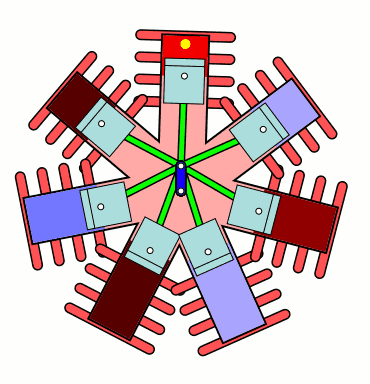For the motor, the rotor is placed in the rotating magnetic field. Under the action of the rotating magnetic field, a rotating torque is obtained, so the rotor rotates. The power range of asynchronous motor is from a few watts to tens of thousands of kilowatts, which can provide power for a variety of mechanical equipment and household appliances.
Motor (commonly known as "motor") is an electromagnetic device that converts or transmits electric energy according to the law of electromagnetic induction. Its main function is to generate driving torque as the power source of electrical appliances or various machines.
The main function of motor is to convert electric energy into mechanical energy.
The motor mainly consists of an electromagnet winding or distributed stator winding used to generate a magnetic field, a rotating armature or rotor and other accessories. Under the action of the rotating magnetic field of the stator winding, a current passes through the armature squirrel cage aluminum frame and rotates it under the action of the magnetic field.
Stator (stationary part)
Stator core: a part of the magnetic circuit of the motor on which the stator winding is placed;
Stator winding: it is the circuit part of the motor, which is connected with three-phase AC to generate rotating magnetic field;
Base: fix the stator core and front and rear end covers to support the rotor and play the role of protection and heat dissipation;
Rotor (rotating part)
Rotor core: as a part of the magnetic circuit of the motor and placing the rotor winding in the core slot;
Rotor winding: cutting the stator rotating magnetic field, generating induced electromotive force and current, and forming electromagnetic torque to rotate the motor;
Schematic diagram of motor
Working principle of stepping motor

Principle of generating current
Difference between maintenance frequency conversion motor and ordinary motor
The maintenance method of variable frequency motor is basically the same as that of ordinary motor. However, due to the particularity of variable frequency power supply, the winding insulation of variable frequency motor is more strict than that of ordinary motor. The following measures to improve the insulation condition should be taken:
1、 Select the electromagnetic wire with good corona resistance to meet the requirements of high-frequency pulse and partial discharge resistance of the motor.
Polyester imide / polyamide imide composite layer enamelled wire, corona resistant and corona resistant electromagnetic wire are generally used.
2、 Winding and embedding construction technology.
The winding, embedding, binding and other processing processes of variable frequency motor must be strictly managed, especially to prevent damage to the conductor in the process of winding and embedding. The slot insulation, phase insulation and interlayer insulation shall be placed in place in the process of embedding. The phase insulation shall be made of materials easily soaked by insulating paint, and the coil ends shall be bound and fixed to ensure that the ends become a whole.
Strengthening insulation at the bottom of the motor slot, between phases, between layers and the first and last turns of the coil can improve the electrical strength of the motor.
3、 The main insulation must be air gap free insulation.
The air gap in the insulation structure of variable frequency motor is the main factor causing corona. In order to ensure that there is no air gap in the overall insulation structure of the motor, according to the provisions of the national standard GB / tz1707-2008 specification for insulation of special three-phase asynchronous motors for frequency conversion and speed regulation, the impregnation paint for special three-phase asynchronous motors for frequency conversion and speed regulation must be no less than grade F solvent-free paint with a volatile content of less than 10%, and VPI process shall be adopted. The process can also improve the overall mechanical strength of the insulation structure.
4、 Match the frequency converter, cable and motor, and limit the length of cable between motor and power supply.
Due to the mismatch of power line impedance, with the increase of cable length from frequency converter to motor, the overvoltage amplitude at motor end increases, which is easy to cause partial discharge. Therefore, the length of the connecting cable shall be shortened as much as possible according to the specific characteristics and actual needs of the variable frequency power supply, so as to reduce the overvoltage amplitude and local discharge at the motor end and prolong the service life of the motor.
The power line of variable frequency motor generally uses professional cable, also known as symmetrical conductor variable frequency cable, which is 3P + 3N / E series, that is, one of the original 3 + 1 is divided into three.





